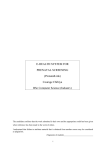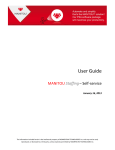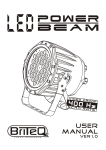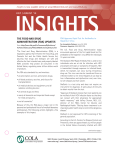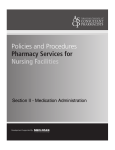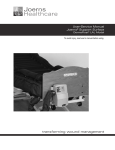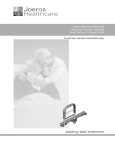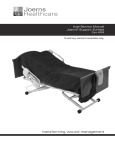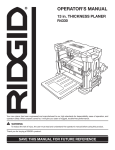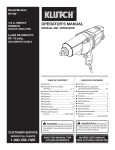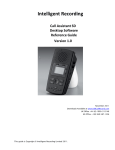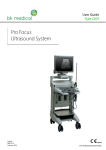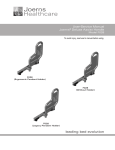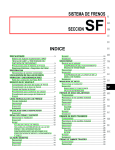Download Supporting Document - Maryland Patient Safety Center
Transcript
guidance ARTICLE TOP 10 TECHNOLOGY HAZARDS FOR 2012 HEALTH TECHNOLOGY OFFERS COUNTLESS BENEFITS. IT ALSO PRESENTS NUMEROUS RISKS. MOST OF THESE CAN BE AVOIDED—WITH WORK. BUT IN A CONSTANTLY CHANGING ENVIRONMENT, IT’S NOT ALWAYS EASY TO KNOW WHERE BEST TO CONCENTRATE YOUR EFFORTS. OUR ANNUAL LIST WILL HELP YOU MAKE SMART DECISIONS ABOUT YOUR SAFETY INITIATIVES DURING 2012. Deciding how to prioritize your efforts when tackling the risks associated with healthcare technology is a continual challenge. Device planning, selection, implementation, use, and support—all these (and more) figure into the choice of which risks to give the greatest attention. Not only are there a lot of areas to consider, but also the technology-safety landscape changes all the time—a new safety technology is introduced, or a new regulation is issued, or a well-recognized hazard makes national headlines, and suddenly you’re forced to reexamine your priorities. That’s why our list of the top 10 health technology hazards is updated each year: to help you focus on the most pressing safety issues over the next 12 months. To develop the list, we’ve weighed a number of factors, particularly those listed below. You can examine the same factors when judging the criticality of each of these hazards for your own facility. How harmful is it? Can it kill someone or cause serious injury? How likely is it? Does it happen often, or very rarely? 358 HEALTH DEVICES NOVEMBER 2011 www.ecri.org If it occurs, is it likely to affect a great number of people, or will the effects be very confined? Is it a high-profile problem? Has it been reported in the media, and are you likely to be under pressure to deal with it quickly and conspicuously? Although this article focuses on specific technology hazards, there are steps you should be taking throughout your facility to make your safety initiatives as effective as possible. See the box titled “General Recommendations” on page 362 for a list of those steps. Finally, we urge you to share this list with others throughout your facility. The hazards in this list affect a wide variety of departments and personnel, including risk management, hospital administration, clinicians, clinical engineering, information technology (IT), nurse managers, and materials management. We encourage you to alert staff in those areas to this list and its recommendations. How widespread is it? ©2011 ECRI Institute. Member hospitals may reproduce this page for internal distribution only. The Risks That Should Be at the Top of Your Prevention List 1. Alarm Hazards Many medical devices in the hospital, such as physiologic monitors (including telemetry monitors), ventilators, infusion pumps, and dialysis units, rely on alarms to help protect patients. But the alarm systems on these devices can also be the source of problems, and there are times when alarms actually contribute to the occurrence of adverse events. Alarm-related adverse incidents may result from a variety of factors: 1. Alarm fatigue, in which staff become overwhelmed by the sheer number of alarms. This can result in alarm desensitization, which in turn can lead to missed alarms or delayed alarm response. Consequently, staff may take inappropriate steps such as: a. Improperly adjusting alarm limits outside the safe and appropriate range for a particular patient in an attempt to reduce the number of alarms. If such modifications are made without careful consideration of the patient’s condition and the alarm’s function, the alarm may be set in such a way that it effectively becomes disabled. Turning down the volume of alarms to an inaudible level in an attempt to reduce alarm fatigue and reduce stress on the patient and family. Staff being unable to distinguish the urgency level of alarms or tell which device an alarm is coming from. b. 2. 3. Alarms not being restored to the active setting after being put on standby (e.g., while the patient has left the floor for testing). 4. Alarms not being properly relayed to ancillary notification systems (e.g., paging system, wireless phones), potentially leading to a failure to notify relevant staff. 5. A lack of adequate alarm-notification and -response protocols. 6. Failure to promptly troubleshoot and correct leads-off alarms or frequent nuisance alarms caused by artifact. ©2011 ECRI Institute. Member hospitals may reproduce this page for internal distribution only. www.ecri.org HEALTH DEVICES NOVEMBER 2011 359 guidance ARTICLE THE HAZARDS AT A GLANCE 1. Alarm hazards 2. Exposure hazards from radiation therapy and CT 3. Medication administration errors using infusion pumps 4. Cross-contamination from flexible endoscopes 5. Inattention to change management for medical device connectivity 6. Enteral feeding misconnections 7. Surgical fires 8. Needlesticks and other sharps injuries 9. Anesthesia hazards due to incomplete pre-use inspection 10. Poor usability of home-use medical devices Alarm safety continues to receive atten- important to consider, don’t let them keep tion. For example, in early 2011, the Boston you from looking at the bigger picture. Globe published a series of articles review- Examine the entire alarm environing periodic efforts by FDA and the Joint ment when setting up your facility’s Commission to address alarm fatigue. And alarm management program for each on October 4 and 5, 2011, a summit on care unit. Your review should take into alarm safety was held to achieve a consenaccount items such as: sus on alarm-safety problems and develop — The full complement and specific action plans. It was co-convened configuration of equipment in by ECRI Institute, the Association for the use (e.g., physiologic monitoring Advancement of Medical Instrumentation system [including telemetry], (AAMI), FDA, the American College of ventilators, infusion pumps, Clinical Engineering (ACCE), and the Joint bed-exit alarms, nurse call) and Commission. how it’s configured, as well as ECRI Institute has produced a poster any associated ancillary alarmcalled “Strategies to Improve Monitor Alarm notification technologies Safety.” It is shown on page 361. You can — Staffing levels, staffing patterns, also download a free copy at www.ecri.org/ and care model Documents/Monitor%20Alarm%20Safety_ — The physical layout of the Poster%20Presentation.pdf. care unit Recommendations Establish protocols for alarm-system settings. These should include definReducing alarm-related adverse incidents ing the default alarm settings for the and setting up an alarm management prospecific care unit—that is, which alarms gram are very complex tasks. They require are active and what their limits are. in-depth assessment of the organization Additionally, establish protocols to as a whole, as well as each individual care guide caregivers in tailoring alarm limits area. Trying to fix one item in isolation may to individual patients to ensure that the provide only a partial solution and may appropriate staff are notified of clinialso introduce new opportunities for failcally significant alarms. ure. While some of our recommendations are specific to individual care areas, and are Establish alarm-notification and -response protocols that ensure that 360 HEALTH DEVICES NOVEMBER 2011 www.ecri.org each alarm will be recognized, that the appropriate caregiver will be alerted, and that the alarm will be promptly addressed. — Clearly assign responsibilities to staff, including who is responsible for recognizing the alarm once it is issued by the device, who is responsible for delivering the necessary alarm information (e.g., existence of an alarm condition, identity of affected patient, reason for alarm, alarm priority) to the responsible caregiver, and who is directly responsible for addressing the alarm. — Establish backup-coverage protocols to ensure that someone responds promptly when the primary caregiver is not available. — Ensure that the correct pager/ phone is assigned to the correct caregiver (e.g., that it is properly programmed to account for staffing changes from shift to shift). Establish policies to control alarm silencing, modification, and disabling. For new care areas, be sure to consider the issues discussed above from the ©2011 ECRI Institute. Member hospitals may reproduce this page for internal distribution only. STRATEGIES TO IMPROVE MONITOR ALARM SAFETY Culture Care Model Patient Population Alarm Management is Complex Delineation of Responsibility Ancillary Technology Alarm Coverage Model Architectural Layout Technology Capabilities & Configuration IT staff Consult with others, as appropriate 1. Assemble a multidisciplinary team Administrative sponsor (e.g., CNO, VP Quality) Key medical staff Nurse managers Front-line nurses Monitor technicians Patient safety/risk manager Clinical engineering staff 2. Review recent events and near misses Root causes Frequency of alarm types Aggregate of alarm types per care area/shift Review remediation/results Trends 3. Observe alarm coverage processes and ask nurses and other staff about their concerns Routine rounding Listen to staff concerns/ problems Map processes for alarm notification and response Identify obvious problems Excessive alarms Difficulty in hearing alarms Delayed alarm response 4. Review entire alarm coverage system Culture Infrastructure Practices Technology 5. Identify patient safety vulnerabilities and potential failures FAILURES Delayed alarm response Transport Communication Breakdown Leads-off Apathy Alarm Fatigue CAUSES 6. Develop realistic, implementable strategies to address underlying causes TODAY FIXES Proper skin prep Proper electrode placement Routine change of electrodes Battery replacement every 24 hours Elevate “Leads-Off Alarms” to crisis priority THINGS Delineate responsibility for alarm response TO Develop a back-up plan with tiers of coverage CONSIDER Delineate responsibility for back-up response Implement two-way communication devices that would allow a nurse to request help Develop an alarm escalation scheme Who receives initial alarm notification for each type of alarm Who receives back-up alarm notification for each type of alarm Time intervals per escalation © 2011 ECRI INSTITUTE, 5200 BUTLER PIKE, PLYMOUTH MEETING, PA 19462-1298 Pagers not being worn Diffuse responsibility for alarm response Competing priorities Assumptions that someone else will respond Excessive nuisance alarms MS11564_4 S Staffing Patterns guidance ARTICLE GENERAL RECOMMENDATIONS In addition to the specific advice provided for each hazard in the Top 10 list, there are certain recommendations that should be followed throughout your facility: Ensure that device-related safety is a corporate priority. Ensure that all clinical staff are qualified (trained, licensed, or certified) for the equipment and treatments offered. Ensure that device problems and incidents are included in a facility-wide adverse event reporting system. — — — Encourage staff to report all events, including near misses, to the manufacturer, ECRI Institute, and the appropriate regulatory agency (e.g., FDA). Institute a standard procedure to assess reported events (including near misses), and establish criteria for determining when events require further analysis, including root-cause analysis. Design the reporting system to be nonpunitive. Before putting devices into service, look for outstanding hazard notices or other safety problems, such as those reported in Health Devices Alerts. earliest planning stages. For existing care programs, make sure that these steps are implemented and that compliance with established protocols is monitored. Resources Health Devices: “Alarm Notification for Physiologic Monitoring: Could You Benefit from a New Strategy?” (Guidance Article, 2007 Jan). “Alarm-Notification Problem Spotlighted in Boston Globe Is All Too Common” (Safety Note, 2010 Apr). “The Hazards of Alarm Overload: Keeping Excessive Physiologic Monitoring Alarms from Impeding Care” (Guidance Article, 2007 Mar). “A Lifesaving Reminder: Improper Use of Ventilator Alarms Places Patients at Risk” (Hazard Report, 2009 Apr). ECRI Institute’s Alarm Safety Resource Site (www. ecri.org/Forms/Pages/Alarm_Safety_Resource. aspx). ECRI Institute’s Patient Safety Blog: Keller J. “Making Clinical Alarm Management a Patient Safety Priority” (2010 Jul 29); www.ecri. org/blog/Lists/Posts/Post.aspx?ID=52. ECRI Institute web conference: “Don’t Kill the Alarm: The Time to Improve Alarm Management Is Now” (2011 May 18). Recording available for purchase: www.ecri. org/Conferences/AudioConferences/Pages/ Improve_Clinical_Alarm_Management.aspx. Additional resources: Association for the Advancement of Medical Instrumentation. Horizons 2011 Spring (focus on improving medical alarm systems). Also available: www.aami.org/alarms/Materials/ Horizons_Alarm_060111_small.pdf. Kowalczyk L: MGH death spurs review of patient Poster: monitors. Boston Globe 2010 Feb 21. Also available: www.boston.com/news/health/ “Strategies to Improve Monitor Alarm Safety” articles/2010/02/21/mgh_death_spurs_ (available free of charge at www.ecri.org/ review_of_patient_monitors. Documents/Monitor%20Alarm%20Safety_ Poster%20Presentation.pdf). No easy solutions for alarm fatigue. Boston Globe 2011 Feb 14. Also available: Health Devices Resource Center: http://articles.boston.com/2011-02-14/ Physiologic Monitoring (https://members2. news/29342842_1_false-alarms-patientecri.org/Components/HDJournal/Pages/ safety-hospitals. ResourceCenter_PhysMon.aspx). See particularly Patient alarms often unheard, unheeded. the pages on managing alarm overload, alarmBoston Globe 2011 Feb 13. Also available: notification strategies, and alarm-enhancement http://articles.boston.com/2011-02-13/ technologies. news/29347393_1_alarms-monitors-nurses. 362 HEALTH DEVICES NOVEMBER 2011 www.ecri.org 2. Exposure Hazards from Radiation Therapy and CT Ionizing radiation is a vital tool for both therapy and diagnosis. But it can cause serious patient harm, instances of which have received national attention over the past few years (see, for example, the Bogdanich articles listed in both sections of the Resources). In radiation therapy, very high levels of radiation are used to deliberately kill tumors. Unfortunately, errors during radiation therapy can have devastating consequences, including ineffective tumor control, as well as critical damage to normal tissue and organs that can lead to severe morbidity and death. It isn’t clear how many patients are affected by radiation therapy errors—for one thing, there isn’t an unambiguous definition of a reportable event—and there is a good chance that incidents are being significantly underreported. In the diagnostic setting, much lower radiation levels are used, and only in extreme cases do noticeable short-term effects, such as hair loss, occur. But far more patients undergo diagnostic radiography, and any cancers resulting from these procedures may only become apparent many years later. CT is a particular concern because it’s being used more and more often and because it has a relatively high dose: It alone contributes about 50% of the entire ©2011 ECRI Institute. Member hospitals may reproduce this page for internal distribution only. radiation dose from artificial sources (NCRP 2009), and one person in 1,000 would be expected to develop cancer in his or her lifetime from a typical CT study, which delivers a dose of approximately 10 mSv (National Academies 2006). When used appropriately, CT is an indispensable diagnostic tool. However, both inappropriate use and inappropriate dose levels can lead to unnecessary radiation exposure to patients; controlling both is essential. One contributing factor is that image quality improves as dose levels are increased, so there is a natural tendency to use higher doses—a tendency facilitated by the lack of a legal maximum dose for CT. Moreover, most healthcare facilities do not routinely audit CT doses, so there is a wide variation in dose for the same types of studies. Consequently, many patients are likely to have been exposed to unnecessarily high radiation levels (SmithBindman et al. 2009). There is a clear need for hospitals to implement robust measures to control these complicated risks. Increasing the focus on this topic is the Joint Commission’s Sentinel Event Alert titled “Radiation Risks of Diagnostic Imaging,” which was issued in August 2011 (see the Radiation Therapy Resources). Be aware of the above-mentioned Sentinel Event Alert issued by the Joint Commission. Ensure that systems are properly installed, commissioned, and maintained. Perform acceptance testing for new systems, as well as for system updates and modifications, and ensure that the integrated systems as a whole meet device performance specifications. (For radiation therapy, this would involve the simulation, treatment planning, delivery, and record and verify systems.) Specific Recommendations for Radiation Therapy Ensure that standard patient treatment procedures are documented and followed, including performing independent double checks and conducting time-outs as appropriate. Develop and use standard checklists for each step of patient treatment. Ensure that new treatment techniques are validated before use. Assess whether your existing testing equipment is adequate for today’s advanced treatment systems. Examine the need for immediate or future additional staffing, training, or professional development activities. Verify that an appropriate subset of key parameters (e.g., radiation beam output) Recommendations is tested regularly and frequently as part There is no simple fix to ensure that of an ongoing quality control program. radiation for therapy and diagnosis is used Specifi c Recommendations for CT safely and effectively. A comprehensive review of all aspects of operations and Ensure that radiologists and medical quality assurance is needed. ECRI Institute physicists are accessible to all clinical recommends the following: staff for consultations and education regarding the appropriate use of diagGeneral nostic imaging. Ensure that staffing levels are adequate. Ensure that radiation doses are as low as Commit to a nationally recognized reasonably achievable while maintaining accreditation certification. acceptable diagnostic image quality. Verify that appropriate quality assur Validate all study protocols before rouance and quality control procedures are tine clinical use. in place and documented. Oversight Record and audit radiation doses. and peer review of these procedures should be conducted. ©2011 ECRI Institute. Member hospitals may reproduce this page for internal distribution only. Provide guidance to radiologists and technologists regarding image quality and dose. Recommend applicable radiation dose mitigation technologies. Radiation Therapy Resources Health Devices Alerts: “ECRI Institute Health Devices Alerts Database Analysis—Radiation Therapy” (Accession No. S0209, 2011 Mar 25). “ECRI Institute Responds to Recent News Coverage of Radiation Therapy Overexposure Incidents” (Accession No. S0198, 2010 Jan 28). ECRI Institute’s Patient Safety Blog: Inamdar R. “Radiation Therapy: A DoubleEdged Sword” (2010 Jun 2); www.ecri.org/blog/ Lists/Posts/Post.aspx?ID=33. ECRI Institute web conference: “Radiation Therapy Errors: Protecting Patients from Harm” (2010 May 19). Recording and CDROM toolkit available for purchase: www.ecri. org/Conferences/AudioConferences/Pages/ Radiation_Therapy_Errors.aspx. Additional resources: Bogdanich W: As technology surges, radiation safeguards lag. N Y Times 2010 Jan 26. Also available: www.nytimes.com/2010/01/27/us/ 27radiation.html?emc=eta1. Case studies: when medical radiation goes awry. N Y Times 2010 Jan 26. Also available: www.nytimes.com/2010/01/27/ us/27RADIATIONSIDEBAR.html. Radiation offers new cures, and ways to do harm. N Y Times 2010 Jan 23. Also available: www.nytimes.com/2010/01/24/ health/24radiation.html?ref=health. Bogdanich W, Rebelo K. They check the medical equipment, but who is checking up on them? N Y Times 2010 Jan 26. Also available: www.nytimes.com/2010/01/27/ us/27sideradiation.html. Hendee WR, Herman MG. Improving patient safety in radiation oncology. Med Phys 2011 Jan; 38(1):78-82. Joint Commission. Radiation risks of diagnostic imaging. Sentinel Event Alert 2011 Aug 24; issue 47. Also available: www.jointcommission.org/ assets/1/18/SEA_471.PDF. National Council on Radiation Protection and Measurements (NCRP). Ionizing radiation www.ecri.org HEALTH DEVICES NOVEMBER 2011 363 guidance ARTICLE NEW SELF-ASSESSMENT TOOL ADDED TO TOP 10 HAZARDS RESOURCE CENTER We’re adding a brand-new feature to our Top 10 Technology Hazards Resource Center: the Health Technology Hazard Self-Assessment Tool. It allows you to gauge your risk of experiencing any of the hazards on our Top 10 list. For each of the hazards, you can send a brief survey to an appropriate person at your facility, who answers questions about how the relevant devices or systems are being used. The survey tool processes the answers and generates a bar graph that rates your level of risk for each of the hazards from low to high. This will help you to focus your mitigation strategies on the hazards that are most relevant to your institution. The self-assessment tool will be updated annually in conjunction with the release of each new Top 10 Hazards list. In addition, the Top 10 Hazards Resource Center is being updated with the hazards for 2012. The site also includes links to the archive of previous years’ hazards and a video about the list from James P. Keller, Jr., vice president for health technology evaluation and safety, who directs the Health Devices Group. You can access the Top 10 Resource Center from your membership home page. exposure of the population of the United States. Report no. 160. Bethesda (MD): NCRP; 2009. Pennsylvania Patient Safety Authority. Errors in radiation therapy. Pa Patient Saf Advis 2009 Sep;6(3):87-92. Also available: http:// patientsafetyauthority.org/ADVISORIES/ AdvisoryLibrary/2009/Sep6(3)/Pages/ Home.aspx. Terezakis SA, Pronovost P, Harris K, et al. Safety strategies in an academic oncology department and recommendations for action. Jt Comm J Qual Patient Saf 2011 Jul;37(7):291-9. World Health Organization (WHO). Radiotherapy risk profile. Geneva: WHO; 2008. Also available: www.who.int/patientsafety/activities/ technical/radiotherapy_risk_profile.pdf. CT Resources Health Devices: “CT Radiation Dose: Understanding and Controlling the Risks” (Guidance Article, 2010 Apr). “Radiation Dose in Computed Tomography: Why It’s a Concern and What You Can Do about It” (Guidance Article, 2007 Feb). Health Devices Resource Center: Computed Tomography (https://members2. ecri.org/Components/HDJournal/Pages/ Computed-Tomography-Resource-Center.aspx). Health Devices PowerPoint presentation: “CT Radiation Dose Safety.” ECRI Institute’s Patient Safety Blog: Keller J. “CT Radiation Safety—Now It’s Personal” (2010 Aug 5); www.ecri.org/blog/ Lists/Posts/Post.aspx?ID=53. 364 Additional resources: American College of Radiology. ACR appropriateness criteria [online]. www.acr.org/ secondarymainmenucategories/quality_safety/ app_criteria.aspx. Berrington de Gonzalez A, Mahesh M, Kim KP, et al. Projected cancer risks from computed tomographic scans performed in the United States in 2007. Arch Intern Med 2009 Dec;169(22):2071-7. Bogdanich W: After stroke scans, patients face serious health risks. N Y Times 2010 Jul 31. Also available: www.nytimes.com/2010/08/01/ health/01radiation.html?_r=1. West Virginia hospital overradiated brain scan patients, records show. N Y Times 2011 Mar 6. Also available: www.nytimes. com/2011/03/06/health/06radiation.html. Bogdanich W, McGinty JC. Medicare claims show overuse for CT scanning. N Y Times 2011 Jun 17. Also available: www.nytimes.com/ 2011/06/18/health/18radiation. html?pagewanted=all. Fazel R, Krumholz HM, Wang Y, et al. Exposure to low-dose ionizing radiation from medical imaging procedures. N Engl J Med 2009 Aug 27;361(9):849-57. Food and Drug Administration, U.S. Letter to the Medical Imaging Technology Alliance regarding CT recommendations [online]. 2010 Nov 8 [cited 2011 Oct 10]. Available from Internet: www.fda.gov/Radiation-EmittingProducts/ RadiationSafety/RadiationDoseReduction/ ucm232551.htm. HEALTH DEVICES NOVEMBER 2011 www.ecri.org Lauer M. Elements of danger—the case of medical imaging. N Engl J Med 2009 Aug 27; 361(9):841-3. Mertens M. Cedars-Sinai apologizes for radiation errors. NPR Health Blog 2009 Oct 16 [includes link to 2009 Oct 15 statement from Thomas M. Priselac, president and CEO of Cedars-Sinai Medical Center; cited 2010 Oct 11]. Available from Internet: www.npr.org/blogs/ health/2009/10/cedarssinai_says_sorry.html. The National Academies. Health risks from exposure to low levels of ionizing radiation (BEIR) VII—phase 2. Washington (DC): National Academies Press; 2006. Smith-Bindman R, Lipson J, Marcus R, et al. Radiation dose associated with common computed tomography examinations and the associated lifetime attributable risk of cancer. Arch Intern Med 2009 Dec 14;169(22):2078-86. 3. Medication Administration Errors Using Infusion Pumps Patients can be highly sensitive to the amount of medication or fluid they receive from infusion pumps; what’s more, some medications are life-sustaining. Therefore, infusion programming mistakes such as mistyping data or entering it into the wrong field can have severe adverse effects, including death. Infusion pump technology has evolved over the years to address many safety issues, the most notable improvement being the introduction of “smart” pumps. But preventable errors, including misprogramming, do still occur. While administration is the area where errors are most likely to affect the patient (Kirkbride and Vermace 2011), the entire infusion process needs to be examined. This involves many healthcare professionals (doctors, nurses, and pharmacists) who perform various tasks that also may be ripe for mistakes. For example, medication orders may be illegible, drugs and solutions may be incorrectly prepared, and a medication may be given to the wrong patient. Ensuring infusion safety requires teamwork among many departments within a facility and collaboration with infusion pump manufacturers. ©2011 ECRI Institute. Member hospitals may reproduce this page for internal distribution only. In April 2010, FDA issued a white paper (FDA 2010 “Infusion Pump Improvement Initiative”) about improving infusion pump safety and announced that it would be reviewing reported problems and investigating current devices in order to aid in the development of safer and more effective infusion technologies and practices. An FDA/AAMI Infusion Device Summit held in October 2010 identified a few hundred types of pump issues and grouped them into 13 “clarion themes.” AAMI then assembled an Infusion Device Safety Council, with members from academia, device suppliers, healthcare facilities, regulatory agencies, industry groups, and ECRI Institute, which is tackling the 13 clarion themes in 10 workgroups. Readers can learn more about the council and get involved at www.aami.org/foundation/ htsc/infusion/index.html. The proceedings from the safety summit are listed in the Resources. Recommendations View infusion pumps as part of an overall medication delivery system, since infusion pumps are likely to become integrated with other information systems (e.g., pharmacy information system, electronic medical record [EMR]). Determine the pumps’ compatibility with safety systems that are currently in place. In addition to considering the hospital’s current needs, vendor support, and costs when choosing new infusion pump technology, focus on the technology’s possible integration with future medication safety systems, as well as its usability. For example, consider asking the pump supplier for the names of other sites that have integrated the pump with information systems from the major providers. Develop appropriate drug libraries for clinical areas that use infusion pumps. The libraries should have standardized concentrations of commonly used drugs and solutions. To determine appropriate concentrations, consult with other organizations and seek out best practices. When implementing a new infusion system, take advantage of vendor consulting programs. Consider requesting that a representative help the facility troubleshoot problems. Before and during purchasing, be sure to get buy-in from staff members who will be using the system, and emphasize to clinicians the importance of infusion pump technology safeguards. Be aware that there may be resistance to new workflows introduced with new infusion pump technology. Safety system noncompliance must be identified and rectified as soon as possible. Determine how and when infusion pump data will be captured, analyzed, and disseminated. Read the Infusion Device Safety Council report (AAMI 2010), and consider how your facility is addressing the 13 clarion themes. Resources Health Devices: “General-Purpose Infusion Pumps” (Evaluation, 2007 Oct). “Large Volume Infusion Pumps: The Evolution Continues” (Evaluation, 2009 Dec). “Patient-Controlled Analgesic Infusion Pumps” (Evaluation, 2006 Jan). “Syringe Infusion Pumps with Dose Error Reduction Systems” (Evaluation, 2008 Feb). Health Devices Resource Center: Infusion Pumps (https://members2.ecri. org/Components/HDJournal/Pages/ ResourceCenter_LVP0706-2471.aspx). Additional resources: Association for the Advancement of Medical Instrumentation (AAMI). Infusing patients safely. Priority issues from the AAMI/FDA infusion summit. 2010. Also available: www. aami.org/infusionsummit/AAMI_FDA_ Summit_Report.pdf. Food and Drug Administration, U.S.: Infusion pump glossary [online]. 2010 Apr 22 [cited 2011 Apr 11]. Available from Internet: www.fda.gov/MedicalDevices/ ProductsandMedicalProcedures/ ©2011 ECRI Institute. Member hospitals may reproduce this page for internal distribution only. GeneralHospitalDevicesandSupplies/ InfusionPumps/ucm202502.htm. Infusion pump improvement initiative [white paper online]. 2010 Apr [cited 2011 May 5]. Available from Internet: www.fda.gov/MedicalDevices/ ProductsandMedicalProcedures/ GeneralHospitalDevicesandSupplies/ InfusionPumps/ucm205424.htm. Infusion pump risk reduction strategies for facility administrators and managers [online]. 2010 Apr 22 [cited 2011 Apr 21]. Available from Internet: www.fda.gov/MedicalDevices/ ProductsandMedicalProcedures/ GeneralHospitalDevicesandSupplies/ InfusionPumps/ucm205410.htm. What is an infusion pump? [online]. 2010 Apr 22 [cited 2011 May 5]. Available from Internet: www.fda.gov/MedicalDevices/ ProductsandMedicalProcedures/ GeneralHospitalDevicesandSupplies/ InfusionPumps/ucm202495.htm. Kirkbride G, Vermace B. Smart pumps: implications for nurse leaders. Nurs Admin Q 2011 Apr-Jun;35(2):110-8. Pinkney S, Trbovich P, Fan M, et al. Do smart pumps actually reduce medication errors? Hum Factors Horiz 2010:64-9. 4. Cross-Contamination from Flexible Endoscopes Patient cross-contamination from improperly reprocessed flexible endoscopes has affected large groups of patients at hospitals large and small. At minimum, endoscope reprocessing problems, when discovered, can be detrimental to a facility’s reputation and can create anxiety when patients are told they may have been exposed to a contaminated endoscope. At worst, they can lead to life-threatening infections. Such incidents are almost always associated either with failure to follow established cleaning and disinfection/ sterilization guidelines and instructions, or with the use of damaged or malfunctioning equipment. Flexible endoscope reprocessing requires consistent adherence to a multistep procedure. Failure to properly perform any step, including some necessary manual www.ecri.org HEALTH DEVICES NOVEMBER 2011 365 guidance ARTICLE tasks, could compromise the integrity of the process. On a more general note, in October 2011, FDA and AAMI held a Medical Device Reprocessing Summit to identify, discuss, and formulate strategic initiatives and priorities to improve reprocessing of reusable devices. The discussion topics included the definition of “clean,” design issues, personnel competency, and instructions for use. There was discussion of the general lack of understanding of reprocessing needs—for example, clinicians may prefer a given model of device but not appreciate that reprocessing that model could take more than the 15 or 30 minutes available between cases, meaning that reprocessing could be rushed and ineffective. Other key points included the desire for more standardized reprocessing protocols for similar equipment and the need for education and training for central processing personnel. One other helpful idea was reviewing device instructions before purchase. This would allow facilities to identify and possibly avoid devices that are extremely complicated or that call for equipment or supplies not currently in use, thereby eliminating the need to find or purchase additional materials when the device arrives in central processing the first time. Recommendations Ensure that a specific reprocessing protocol exists for each flexible endoscope 366 model in your facility’s inventory. Refer to the device’s user manual and consult the endoscope manufacturer to identify unique requirements (e.g., cleaning procedures, channel adapters) that need to be addressed within each protocol document. Remember to repeat this review for each newly purchased endoscope model, endoscope reprocessor, or related equipment and accessories. Periodically review protocols to ensure that they are clear and comprehensive and that they reflect the current environment. For example, verify that they don’t include obsolete workflows or equipment/chemicals that are no longer in use at the facility. When developing or reviewing protocols, ensure that all steps are addressed and documented in adequate detail— from precleaning of equipment at the treatment site to safe and aseptic transport of equipment back to the treatment site for subsequent use. (Typical steps in a reprocessing protocol are described in our October 2010 Guidance Article “Clear Channels: Ensuring Effective Endoscope Reprocessing.”) If your facility reprocesses endoscopy equipment using a reprocessing unit—such as an automated endoscope reprocessor, a liquid chemical sterilization system, or a gas plasma sterilizer— ensure that: — Endoscopes and related equipment in your facility’s inventory are compatible with the reprocessor and its disinfecting/sterilizing agent. — The appropriate channel adapters are available to connect the endoscope to the reprocessor, and staff are familiar with the correct endoscope/connector combinations. Also ensure that staff have access to information on the correct combinations and know where this information is located if there are any questions. — Staff are familiar with and adhere to appropriate reprocessor HEALTH DEVICES NOVEMBER 2011 www.ecri.org maintenance schedules, including the periodic replacement of particulate and bacterial filters. Ensure that documented protocols are readily available to staff and that staff are trained to understand and follow them. Remember to periodically repeat training to ensure that staff remain familiar with the protocols and to address turnover. Also monitor adherence to protocols. Be alert to the possible need for revisions to protocols and training when a new endoscope model is added to your inventory. Resources Health Devices: “Clear Channels: Ensuring Effective Endoscope Reprocessing” (Guidance Article, 2010 Oct). “Clearing Up Confusion about the Steris System 1E: ECRI Institute’s Perspective on Its Appropriate Use” (Guidance Article, 2010 Dec). “Survey Results: Hospitals’ Status Regarding Steris System 1 Replacement” (Safety Note, 2010 Dec). Health Devices Resource Center: Steris System 1 (https://members2.ecri.org/ Components/HDJournal/Pages/ SterisSystem1ResourceCenter.aspx). Additional resources: Food and Drug Administration, U.S. Preventing cross-contamination in endoscope reprocessing: safety communication from FDA, CDC, and the VA [online]. 2009 Nov 19 [cited 2011 Oct 10]. Available from Internet: www.fda.gov/ MedicalDevices/Safety/AlertsandNotices/ ucm190273.htm. Government Accountability Office, U.S. VA healthcare weaknesses in policies and oversight governing medical supplies and equipment pose risks to veterans’ safety [online]. 2011 May 3 [cited 2011 Oct 10]. Available from Internet: www.gao.gov/products/GAO-11-391. Pennsylvania Patient Safety Authority. The dirt on flexible endoscope reprocessing. Pa Patient Saf Advis 2010 Dec;7(4):135-40. Also available: http://patientsafetyauthority.org/ ADVISORIES/AdvisoryLibrary/2010/dec7(4)/ Pages/135.aspx. Vockley M. Probing the challenges of endoscopes. Biomed Instrum Technol 2011 MayJun;45(3):174-84. ©2011 ECRI Institute. Member hospitals may reproduce this page for internal distribution only. 5. Inattention to Change Management for Medical Device Connectivity Develop contract wording that is specific ECRI Institute is aware of an increasing to change management. For example, number of problems related to change contracts with vendors (e.g., information management, including issues involving system vendors, device suppliers) should wireless networks, cybersecurity, planned require the necessary documents (e.g., maintenance, or software upgrades. revised specifications, software upgrade The growing interrelationship between In one case involving software documentation, test scenarios) to be medical technology and IT—a situation upgrades, a facility had an integrated physiprovided to the appropriately designated referred to as convergence—offers signifi- ologic monitoring system with features hospital staff member(s) to facilitate cant benefits, but it also raises significant that allowed clinicians to access EMR change management. concerns about potential risks to patients flow sheets, use bar codes for medication if the device-IT interface is poorly imple- administration, and view PACS images on Consider applying risk management mented. For example, new hazards can be a patient monitoring display (as opposed principles to change management as introduced through unexpected problems to bringing a workstation on wheels into discussed in the IEC 80001-1 stanwith device performance—problems that the patient room). Unfortunately, when dard, Application of Risk Management occur because of inherent limitations for IT-Networks Incorporating Medical this facility performed a software upgrade within or interactions among any of the Devices—Part 1: Roles, Responsibilities to its physiologic monitoring system, the networked devices, interfaces, or IT-based bar-code medication administration sysand Activities. (Refer to our May 2010 systems. Hazards can arise from software Guidance Article “10 Questions about tem that was integrated with the patient anomalies, problems with interoperability IEC 80001-1” for answers to some monitors went down. Since that incident, between systems, and degraded network common questions about the standard.) the facility performs extensive testing on performance. every software upgrade before distribu Ensure good working relationships tion. They test it in a test lab first, then in a A key reason problems arise is the between departments—particularly IT staged room (where devices are configured failure to implement adequate change and clinical engineering, since these two and operate as they would in a hospital management policies and procedures groups have a direct responsibility for room but with no patient), and then disthat accommodate both IT and medical convergence and change management. tribute it to the hospital. In subsequent technology needs. Change management Remember that help desks are typically is a structured approach for ensuring that software upgrade testing, they have found the first point of contact for problems that with every software update there are modifications to an existing system are relating to change management and performed in a controlled manner. Because at least one to three issues that must be health IT. Education, training, and medical devices and health IT are becom- resolved before the software upgrade can good escalation procedures can help to ing so interconnected, healthcare facilities be distributed. ensure that help desks respond to probmust be aware of a possible domino effect lems with the appropriate urgency. wherein changes to one component of the Recommendations system affect the operation of another. Take steps to ensure that changes are Resources assessed, approved, and implemented Health Devices: in a controlled manner. Change man“10 Questions about IEC 80001-1: What You agement applies to a variety of actions, Need to Know about the Upcoming Standard including hardware upgrades, softand Networked Medical Devices” (Guidance ware upgrades, security changes, new Article, 2010 May). applications, new work processes, and “CE/IT Collaboration: Putting the Pieces planned maintenance. Together” (Guidance Article, 2009 May). Evaluate your facility’s policies and “Coping with Convergence: A Road Map for Successfully Combining Medical and procedures regarding change manageInformation Technologies” (Guidance Article, ment to ensure that situations involv2008 Oct). ing convergence and health IT are “Data-Transfer Problems between Imaging properly addressed. Care should be Devices and PACS Could Result in taken to determine how technology Misdiagnosis” (Hazard Report, 2008 Dec). decisions involving medical devices “Look Who’s Talking: A Guide to Interoperabiland IT networks can affect current ity Groups and Resources” (Guidance Article, operations, patient care, and clinician 2011 Jun). work processes. ©2011 ECRI Institute. Member hospitals may reproduce this page for internal distribution only. www.ecri.org HEALTH DEVICES NOVEMBER 2011 367 guidance ARTICLE “Physiologic Monitoring: A Guide to Networking Your Monitoring Systems” (Evaluation, 2011 Oct)—see particularly the discussion of change management on pages 326-7. Health Devices PowerPoint presentation: “Coping with Convergence: A Road Map for Combining Medical and Information Technologies.” during enteral feeding usually take one of two forms: 1. Nutrients intended for the GI tract are inadvertently delivered elsewhere (e.g., the vasculature). Inappropriate fluids (e.g., IV solutions) are inadvertently delivered to ECRI Institute web conferences: the GI tract. “Avoid Risk with Health Information By far, the first hazard is the more critical Technology” (2011 Mar 16). Recording and CDone: It can easily result in death, usually by ROM toolkit available for purchase: www.ecri. embolus or sepsis (Bankhead et al. 2009). org/Conferences/AudioConferences/Pages/ Health_Information_Technology.aspx. In 2005, a voluntary standard, Ameri“Avoiding the Pitfalls of Medical Device can National Standard ANSI/AAMI Connectivity” (2011 Oct 12). Archive ID54:1996/(R)2005, Enteral Feeding Set recording available for purchase: www.ecri. Adapters and Connectors, was introduced to org/Conferences/AudioConferences/Pages/ reduce the risk of misconnecting enteral Medical-Device-Connectivity.aspx. administration sets to unintended medical PSO Navigator (published by ECRI Institute’s patient lines that employ a female Luer connecsafety organization, ECRI Institute PSO): tion. Unfortunately, this standard has not “Patient Safety at Intersection of Medical and had a major impact in preventing misconInformation Technology” (2011 Aug). nections. One reason is that, as a voluntary Additional resources: standard, it cannot actually prohibit the use American National Standards Institute/ of adapters (which can allow two lines to Association for the Advancement of Medical be connected that should not be). Instrumentation/International Electrotechnical Commission (ANSI/AAMI/IEC). Application of FDA highlighted the dangers associrisk management for IT networks incorporating medical ated with misconnections of enteral devices—part 1: roles, responsibilities and activities. feeding tubes in a July 9, 2010, letter to ANSI/AAMI/IEC 80001-1. 2010 Oct. Food and Drug Administration, U.S. Testimony manufacturers, healthcare professionals, and purchasing departments (FDA 2010). of Jeffrey Shuren, Director of FDA’s Center of FDA urged manufacturers to implement Devices and Radiological Health [online]. 2010 Feb 25 [cited 2010 Oct 11]. A PDF of the tessafeguards such as color-coding and to timony can be downloaded from the “February build “designed incompatibility” into 25, 2010 HIT Safety Hearing” section available their products to help reduce or prevent at: http://healthit.hhs.gov/portal/server.pt?ope n=512&objID=1473&&PageID=17117&mode misconnections. =2&in_hi_userid=11673&cached=true. At this time, the International OrganiJoint Commission. Safely implementing health zation for Standardization (ISO) is working information and converging technologies. Sention a standardized enteral connector. The nel Event Alert 2008 Dec 11; issue 42. Also avail- group has a few design proposals on the able: www.jointcommission.org/SentinelEvents/ table. However, after a design is selected, SentinelEventAlert/sea_42.htm. it will need to go through bench testing and clinical testing. It will therefore not be available for some time. 6. Enteral Feeding Misconnections Enteral feeding is the delivery of nutrients via a tube into the gastrointestinal (GI) tract of individuals who cannot receive food and nutrients by normal means because of a health condition. Misconnection incidents 368 2. Recommendations Given the limited non-Luer design solutions currently available for enteral feeding, hospitals need to implement special precautions to minimize misconnection risks. HEALTH DEVICES NOVEMBER 2011 www.ecri.org Below, we list recommendations specific to addressing these risks. In developing them, we made particular use of Bankhead et al. (2009) and Guenter et al. (2008). We have divided the list into (1) work practice solutions directed toward clinical users and (2) policy-level solutions directed toward patient safety officers, clinical engineers, risk management staff, and purchasing (materials management) personnel. Some of the items are quoted directly from their sources, while others are paraphrased. Work Practice Solutions for Clinical Staff Whenever possible, use enteral pumps for enteral feeding. Trace lines from end to end when making an initial connection (e.g., upon the patient’s arrival in a new setting or service) and any time you are making a reconnection. Never use a standard Luer syringe for oral medications or enteral feedings. Do not modify or adapt IV or feeding devices; doing so may compromise the safety features incorporated into their design. Label or color-code feeding tubes and connectors and, since there is no standard in color coding, educate staff about the labeling or color-coding system. Examine any identification label before administering a solution to be sure that it is administered via the intended route. Do not rely on the solution’s appearance for identification; enteral formula may look like some IV solutions (e.g., lipid-containing solutions, three-in-one admixtures), which have a milky appearance, thus creating the risk that an enteral container will be mistakenly spiked with an IV administration set. Label the bags with large, bold statements such as “WARNING! For Enteral Use Only—Not For IV Use.” Policy-Level Solutions for Nonclinical Staff Purchase enough enteral pumps that IV pumps don’t have to be used for enteral delivery. If syringe pumps are used in ©2011 ECRI Institute. Member hospitals may reproduce this page for internal distribution only. neonatal intensive care units for human milk or other feedings, they should be clearly distinct from syringe pumps used for IV or other medical purposes. Consider using non-Luer tubing technologies to prevent mix-ups. Limit the length of contracts for purchasing administration sets to one year to allow for the switch to a standardized connector once available. Ensure that hospital purchasing policies mandate buying only enteral feeding sets that are compliant with the ANSI/ AAMI ID54 standard, which excludes any sets that are compatible with female Luer connectors and excludes adapters that would allow such connections. When purchasing prefilled enteral feeding containers, purchase only those that are non-IV-compatible. Ensure that enteral administration sets are packaged with the enteral feeding bag or container before it is sent to the patient care unit. The set should be secured to the bag, perhaps with a rubber band, or preattached sets should be requested from the manufacturer. Obtain enteral pumps that feature an automatic flush mode. This will keep clinicians from having to manually flush lines and therefore will make them less likely to use an adapter or Luer device between the enteral administration set and the feeding tube. during which oxygen accumulation creates an enriched atmosphere—are discussed in detail in our October 2009 Guidance Article “New Clinical Guide to Surgical Fire Prevention” and summarized in our second recommendation below. Some healthcare facilities take active steps to educate staff on the dangers of surgical fires. One healthcare system, for example, has heightened its clinicians’ awareness of the risks of surgical fires by adding a Surgical Fire Risk Assessment Score (www.christianacare.org/FireRisk Assessment) to its perioperative forms for verifying the surgical site and patient identification (Mathias 2006). Before surgery, the surgical team is required to identify and assess several fire risk potentials—includ ing, for example, the use of alcohol-based skin prep solutions and the use of open oxygen sources on the face. The initia tive at this healthcare system has served to stimulate collaborative communication among surgical team members. 7. Surgical Fires Formal training and drills are recomECRI Institute continues to receive reports mended by ECRI Institute and APSF. of surgical fires at a rate of about one or APSF commissioned ECRI Institute to two per week. Our research indicates that produce a training video on surgical fires. there are approximately 600 surgical fires The 18-minute video is available as a free in the United States each year. Not all sur- download from the APSF website (www. gical fires result in patient injury, but when apsf.org/resources_video.php); the orgathey do, the consequences can be severe, nization also offers DVDs of the video including potentially fatal airway burns and at no charge. ECRI Institute’s surgical fire horrible facial disfigurement. prevention and extinguishment educational Virtually all surgical fires can be avoided. But doing so requires that each member of Resources the surgical team clearly understands the Health Devices: role played by oxidizers, ignition sources, “Fixing Bad Links: Preventing Misconnections and fuels in the operating room. Each team in Your Hospital” (Guidance Article, 2009 Jul). member should also make a point of comAdditional resources: municating information on the risks to American National Standards Institute (ANSI)/ other team members—intraoperatively or Association for the Advancement of Medical in seminars, for example. Instrumentation (AAMI). Enteral feeding set In 2009, new clinical practice recomadapters and connectors. ANSI/AAMI ID54-1996. mendations for delivering oxygen during 1996 (reaffirmed 2005). Bankhead R, Boullata J, Brantley S, et al. A.S.P.E.N. surgery were developed by ECRI Institute enteral nutrition practice recommendations. J in conjunction with the Anesthesia Patient Parenter Enteral Nutr 2009 Mar-Apr;33(2):122-67. Safety Foundation (APSF). These recomFood and Drug Administration, U.S.: mendations—which focus on surgeries to the head, face, neck, and upper chest, Letter to manufacturers, healthcare professionals, and purchasing departments regarding preventing misconnections [online]. 2010 Jul 9 [cited 2011 Oct 18]. Available from Internet: http://www.fda.gov/downloads/ MedicalDevices/ResourcesforYou/ Industry/UCM218631.pdf. Medical device safety calendar 2009 [online]. 2009 [cited 2009 Jun 18]. Available from Internet: www.fda.gov/downloads/ MedicalDevices/Safety/AlertsandNotices/ UCM134869.pdf. Guenter P, Hicks RW, Simmons D. Enteral feeding misconnections: an update. Nutr Clin Pract 2009 Jun-Jul;24(3):325-34. Guenter P, Hicks RW, Simmons D, et al. Enteral feeding misconnections: a consortium position statement [USP Medication Safety Forum]. Jt Comm J Qual Patient Saf 2008 May;34(5):285-92. Joint Commission. Tubing misconnections— a persistent and potentially deadly occurrence. Sentinel Event Alert 2006 Apr 3;(36):1-3. Simmons D, Symes L, Guenter P, et al. Tubing misconnections: normalization of deviance. Nutr Clin Pract 2011 Jun;26(3):286-93. ©2011 ECRI Institute. Member hospitals may reproduce this page for internal distribution only. www.ecri.org HEALTH DEVICES NOVEMBER 2011 369 guidance ARTICLE posters are available for free downloading (see the Resources). FDA’s Center for Devices and Radiological Health (CDRH) convened a meeting in 2010 with representatives from a variety of healthcare organizations to discuss ways to collaborate to prevent surgical fires (www.fda.gov/Drugs/DrugSafety/ SafeUseInitiative/ucm239511.htm). The result of that ongoing initiative is a page on FDA’s website, posted in October 2011, that aggregates surgical fire prevention information and educational tools (see the Resources). Recommendations If you don’t already have one, implement a surgical fire prevention and management program, including training, based on the recommendations for preventing and extinguishing surgical fires presented in our October 2009 Guidance Article. To minimize the risks posed by oxygenenriched atmospheres, become familiar with and implement the new clinical recommendations on oxygen delivery from APSF and ECRI Institute. (Again, see our October 2009 Guidance Article and educational posters for details.) The core point of these recommendations is that, with certain limited exceptions, the traditional practice of open delivery of 100% oxygen should be discontinued during head, face, neck, and upperchest surgery. Only air should be used for open delivery to the face, provided that the patient can maintain safe blood oxygen saturation without supplemental oxygen. If the patient cannot do this, secure the airway with a laryngeal mask airway or tracheal tube to prevent the excess oxygen from contaminating the surgical site. The surgical team should have a timeout before the case begins and assess any fire risks. Ensure that this time-out is conducted effectively. 370 rate among hospital workers of 28 injuries per year per 100 occupied beds (MassachuHealth Devices: setts Department of Public Health 2010). “New Clinical Guide to Surgical Fire Prevention: Sharps injuries include those sustained Patients Can Catch Fire—Here’s How to Keep (and inflicted on others) by clinicians trying Them Safer” (Guidance Article, 2009 Oct). to activate needlestick-prevention devices. Posters (available free of charge at www.ecri.org/ A recent article published in Infection Consurgical_fires): trol & Hospital Epidemiology concluded that “Surgical Fire Prevention.” passive safety-engineered devices were “Emergency Procedure—Extinguishing a significantly more effective than those that Surgical Fire.” were manually activated. During this study, Health Devices PowerPoint presentation: more than one-fourth of all the needlestick “New Clinical Guide to Surgical Fire injuries were from nonactivation or incomPrevention.” plete activation of the device and could Additional resources: have been avoided (Tosini et al. 2010). American Society of Anesthesiologists Task What’s more, clinicians and custodial staff Force on Operating Room Fires, Caplan RA, Barker SJ, et al. Practice advisory for the preven- continue to get stuck while using or handling sharps disposal containers. tion and management of operating room fires. Anesthesiology 2008 May;108(5):786-801. Also Most hospitals have ongoing programs available: www.asahq.org/sitecore/content/ to address sharps safety. But these proLifeline/Anesthesia-Topics/~/media/Lifeline/ grams may have been established some Anesthesia%20Topics/OR%20Fires%20 time ago and may no longer be receivPractice%20Guidelines.ashx. ing adequate attention or achieving their Anesthesia Patient Safety Foundation (APSF). Prevention and management of operating room expected level of effectiveness. Continuing fires [video]. Indianapolis: APSF; 2010. Also injuries are a signal that additional attenavailable: www.apsf.org/resources_video.php. tion is needed; it could be that clinicians Food and Drug Administration, U.S. Preventing are using poor technique, that the safety surgical fires: collaborating to reduce preventable devices being used should be replaced with harm. 2011 Oct [cited 2011 Oct 18]. Available more effective models, or that gaps exist in from Internet: www.fda.gov/Drugs/ the facility’s sharps safety program. DrugSafety/SafeUseInitiative/ PreventingSurgicalFires. An effective sharps safety program Joint Commission. Preventing surgical fires. Sen- will include input from a variety of staketinel Event Alert 2003 Jun 24; issue 29. Also availholders. Thus, a typical sharps safety Resources able: www.jointcommission.org/assets/1/18/ SEA_29.PDF. Mathias JM. Scoring fire risk for surgical patients. OR Manager 2006 Jan;22(1):19-20. 8. Needlesticks and Other Sharps Injuries Exposure to bloodborne pathogens (hepatitis B virus [HBV], hepatitis C virus [HCV], and human immunodeficiency virus [HIV]) from needlesticks and other sharp instruments used in the healthcare environment continues to be a serious problem. According to a report from the Massachusetts Sharps Injury Surveillance System, the year 2009 saw a sharps injury HEALTH DEVICES NOVEMBER 2011 www.ecri.org ©2011 ECRI Institute. Member hospitals may reproduce this page for internal distribution only. committee will include personnel from risk management, materials management, nursing, clinical laboratory, and pharmacy, as well as the patient safety committee, frontline healthcare workers (in the United States, the Occupational Safety and Health Administration [OSHA] requires that they be involved), and housekeeping staff. A new campaign called “Stop Sticks,” launched in 2011 by the National Institute for Occupational Safety and Health (NIOSH), is designed to raise awareness about sharps safety and to prepare and motivate healthcare workers—mainly operating room and emergency department staff—to make the changes necessary to reduce sharps injuries. More information is available online (see “CDC/NIOSH Stop Sticks Campaign” in the Resources). Recommendations To achieve consistent success in preventing needlesticks and other sharps injuries, facilities should annually review and refine all aspects of their sharps safety efforts. We recommend that the sharps safety committee perform the following activities: Assess injuries and current practices—Analyzing information about needlesticks and other sharps injuries that have occurred in your facility is essential for designing or assessing a program. Such an analysis can help you identify where and when (e.g., during which procedures or applications) such injuries typically occur. For instance, if your hospital already has sharps safety devices in place, historical and current data is helpful for deciding whether a particular safety device should be replaced with a new one. Define specific objectives—The data collected on injuries, devices, and current practices will help you define or refine the objectives of your program and prioritize your efforts. Establish an action plan—Within each action plan, each identified category of injury should have some plan for remediation or recommendation for action. The plan should also specify who is responsible for implementing particular aspects of the program, when specific milestones should be completed, and what results the facility expects to achieve. Implement the program—Some of the more challenging aspects include: — Ensuring that all personnel on all shifts are trained. — Obtaining supplier support for in-service training on the use of the protective devices that will be implemented. — Making supplies readily available and removing sharps that are to be replaced by protective devices. Evaluate the program’s effectiveness annually, using the above recommendations for guidance. Resources Health Devices: “Needlestick-Prevention Devices: Disposable Syringes and Injection Needles” (Evaluation, 2007 Aug). “Sharps Disposal Containers” (Evaluation, 2003 Jul); many of the containers rated in this Evaluation are still on the market, and the technology guidance is still valid. “Still Getting Stuck—Protective Devices Alone Won’t Always Prevent Needlestick Injuries” (Hazard Report, 2009 Sep). Health Devices Alerts: “Cardinal Health/Bard—Huber Plus Non-coring Needle Safety Infusion Sets: Needle Tip May Protrude from Safety Sheath, Creating Potential for Needlestick Injury” (Accession No. A13426, 2010 Feb 3). Bae SH, Mark B, Fried B. Use of temporary nurses and nurse and patient safety outcomes in acute care hospital units. Health Care Manage Rev 2010 Oct-Dec;35(4):333-44. Batchelor L. Toddler pricked by contaminated needles [online]. 2010 Oct 22 [cited 2010 Oct 26]. Available from Internet: www.cnn. com/2010/US/10/22/us.child.needles/index. html?iref=allsearch. Centers for Disease Control and Prevention/ National Institute for Occupational Safety and Health. The Stop Sticks campaign: campaign user’s guide and resources. Available from Internet: www.cdc.gov/niosh/stopsticks/. Institute for Safe Medication Practices. Needlestick injury due to label issue with Lovenox unit dose injection [online]. ISMP Med Saf Alert 2010 Jul 23. Available from Internet: www.ismp.org/newsletters/acutecare/articles/ lovenox_alert_v5_layout_1.pdf. Jagger J, Berguer R, Phillips EK, et al. Increase in sharps injuries in surgical settings versus nonsurgical settings after passage of national needlestick legislation. J Am Coll Surg 2010 Apr;210(4):496-502. Massachusetts Department of Public Health Occupational Health Surveillance Program. Sharps injuries among hospital workers in Massachusetts, 2009: findings from the Massachusetts Sharps Injury Surveillance System. Boston (MA): Massachusetts Department of Public Health; 2010. Also available: www.mass.gov/Eeohhs2/ docs/dph/occupational_health/injuries_ hospital_2009.pdf. Tosini W, Ciotti C, Goyer F, et al. Needlestick injury rates according to different types of safety engineered devices: results of a French multicenter study. Infect Control Hosp Epidemiol 2010 Apr;31(4):402-7. 9. Anesthesia Hazards due to Incomplete Pre-use Inspection Each year, we receive reports of staff members discovering serious problems with anesthesia equipment just before it is to be used on a patient. There are also ECRI Institute Special Report: many reports in FDA’s Manufacturer Sharps Safety and Needlestick Prevention, 2nd edition (2003); this publication includes our evaluations and User Facility Device Experience (MAUDE) database describing problems of more than 90 protective devices, many of which are still on the market. that were discovered while the device was in use on a patient. These reports cover Additional resources: misconnected breathing circuits, ventilaHealth Devices PowerPoint presentation: “Sharps Safety—Maintaining an Effective Sharps Injury Prevention Program.” ©2011 ECRI Institute. Member hospitals may reproduce this page for internal distribution only. www.ecri.org HEALTH DEVICES NOVEMBER 2011 371 guidance ARTICLE siologists, anesthesia technicians, or nurse anesthetists) do the following: Before the first case of the day, perform an equipment inspection that includes the model-specific, manufacturer-prescribed full check of the anesthesia unit. Before each subsequent case, make sure that any inspection of the anesthesia unit is, at minimum, the manufacturer-prescribed abbreviated check for that model of anesthesia unit. If you’re unsure whether you’re using the correct procedure for the anesthesia unit models in your inventory, contact the manufacturer. Ensure that staff members or anyone tor leaks, empty gas cylinders, and many responsible for pre-use checks is familother problems that, if unnoticed, may iar with the procedure and the critical lead to patient injury. In a February 2009 need to perform it in its entirety. Hazard Report, we discussed a severe Facility policy should clearly indicate patient injury that resulted from the miswhich staff member (or members) connection of the breathing circuit in an is responsible for performing the anesthesia unit. check. This is particularly important in Thorough pre-use inspection of facilities where the procedure is split anesthesia units has long been accepted up among different roles (for example, as a standard procedure. However, in the anesthesia provider performs some actual practice, such inspections can be steps, and the anesthesia technicians inconsistent and incomplete. Hospital perform others). staff sometimes conduct pre-use checks Include in the inspection not just the using obsolete procedures or procedures anesthesia unit, but also other impordesigned for anesthesia units other than tant devices and accessories (e.g., airway the one being used. Additionally, staff may suctioning equipment, manual resusciskip a portion of the inspection simply tators) that may not be specified in the because they do not understand its imporprocedure for the unit. tance or because they mistakenly believe Make sure the pre-use check procedure that the step is performed by the unit’s is easily accessible. If a hard copy of semiautomated self-check (a common feathe procedure is required, make sure ture in currently marketed anesthesia units) that it is physically attached to the or by another person. Regardless of the anesthesia unit or is placed in some reason, missing or skipping any portion other equally prominent location. Many of the inspection leaves the safety of the later-model anesthesia units perform anesthesia unit in question and increases much of the procedure semiautomatithe risk of patient injury. cally or display step-by-step procedures onscreen. However, any manual porRecommendations tions of the procedure, such as those To help ensure that anesthesia units and that must be performed or confirmed related equipment are safe for patient by a human, should be specified on the use, we recommend that the appropriate attached hard-copy checklist. staff member or members (e.g., anesthe- 372 HEALTH DEVICES NOVEMBER 2011 www.ecri.org Be sure to document the results of the pre-use inspection to allow providers to confirm that all necessary steps have been performed. Resources Health Devices: “Anesthesia System Pre-use Checks: The Importance of Performing a Complete Check on a Consistent Basis” (Evaluation box article, 2006 Jul). “Dangerous Misconnection Goes Undetected by Datex-Ohmeda ADU’s Pre-use Check” (Hazard Report, 2009 Feb). Additional resource: American Society of Anesthesiologists. Recommendations for pre-anesthesia checkout procedures [online]. 2008 [cited 2011 Oct 10]. Available from Internet: http://asatest.asahq. org/clinical/fda.htm. 10. Poor Usability of Home-Use Medical Devices As the U.S. population rapidly ages and the number of individuals living with chronic conditions increases, more patients are receiving medical care in their homes. Unlike hospitals and nursing homes, home care settings involve limited direct supervision of caregivers and equipment performance. These factors increase the risk that problems, errors, and hazards may go undetected or unreported. Often, devices that are used in the home are not designed with the lay user in mind. They are frequently very difficult to use or very complex, and in fact may sometimes be identical to devices used in the hospital by clinicians. In addition, there may be inadequate training for the patient or caregiver. Since June 2010, ECRI Institute has published three Hazard Reports related to problems with medical devices used in the home, all of them involving devices that were not inherently easy to use. One report noted that an alarm could be disabled on an oxygen concentrator when a low-flow flowmeter is placed on ©2011 ECRI Institute. Member hospitals may reproduce this page for internal distribution only. the device; in another, model-specific variations in how ventilator parameters are set could cause improper ventilation; in the third, pressing a specific key on an enteral feeding pump could cause it to appear to be infusing even though an occlusion exists. (See the three Health Devices articles listed in the Resources.) FDA is also concerned about hazards involving medical devices in use in the home and launched an initiative in April 2010 to scrutinize the issues with these devices. According to FDA, approximately 7.6 million individuals in the United States currently receive home healthcare. FDA has identified three unique challenges of the home environment: caregiver knowledge, environmental unpredictability, and device usability. In the area of device usability, FDA outlines the following concerns: Many of the devices used in the home are older and have no labeling or instructions for use or maintenance with them. And if they do, the instructions are not typically written for the lay user. Further, patients usually cannot choose the device they use in the home; it is either prescribed by a doctor or depends on the patient’s insurance or medical equipment supply company. Finally, some devices purchased on the Internet may not come with instructions covering use or maintenance, or information about compatible accessories (FDA 2010). Recommendations ECRI INSTITUTE REPRINT POLICY ECRI Institute makes reprints of individual articles or complete publications available for educational purposes. The purchase and use of these reprints are subject to restrictions, including those imposed by copyright law and our strict no-commercialization policy. For further information, contact Client Management Services by phone at +1 (610) 825-6000, ext. 5891, or by e-mail at [email protected]. home use purposes unless it has been expressly designed for that application. Ensure that you are receiving recalls and alerts on all devices that are prescribed to patients. Ensure that procedures are in place to disclose information about adverse events and recalls to the patient and that the procedures clearly define who is responsible for the disclosure and what is required of the patient. Resources Health Devices: Assess the patient and caregiver(s) “Incorrect Key Presses May Cause Nutricia before prescribing any medical device Flocare Infinity Series Enteral Feeding Pumps to ensure that the patient can use the to Appear to Be Infusing Even Though an technology appropriately. Reassess Occlusion Exists” (Hazard Report, 2011 May). the patient regularly and any time the “No-Flow Alarm Disabled in Respironics EverFlo Oxygen Concentrators Equipped patient experiences a clinical event. with Optional Low-Flow Flowmeter” (Hazard Ensure that patient education materiReport, 2011 Apr). als are provided to patients and their “Unfamiliarity with Differences in the Way caregivers so that they can be easily Ventilators Set Pressure-Control Values May Lead referenced over time. to Lung Injuries” (Hazard Report, 2010 Jun). When patients leave the hospital, be Additional resources: sure that they have appropriate contact Food and Drug Administration, U.S.: information for the hospital or the home Home use devices: how to prepare for and health agency, in case they have queshandle power outages [online]. 2011 [cited 2011 Oct 10]. Available from Internet: tions on the use of the medical device. www.fda.gov/downloads/MedicalDevices/ Educate patients and their family memProductsandMedicalProcedures/ bers or caregivers on the appropriate HomeHealthandConsumer/ use of the technology, and ensure that UCM252812.pdf. they understand the relative risks and Medical device home use initiative benefits involved. [online]. 2010 Apr [cited 2011 Oct 10]. Available from Internet: www. When purchasing devices, be sure to fda.gov/downloads/MedicalDevices/ consider the home healthcare market. ProductsandMedicalProcedures/ Look for devices that are designed for HomeHealthandConsumer/ the lay user. Do not consider using HomeUseDevices/UCM209056.pdf. h older hospital medical equipment for ©2011 ECRI Institute. Member hospitals may reproduce this page for internal distribution only. www.ecri.org HEALTH DEVICES NOVEMBER 2011 373


















